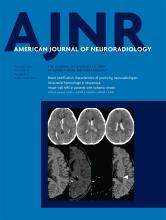Abstract
BACKGROUND AND PURPOSE: White matter hyperintensities on T2-weighted MR imaging are typical in older adults and have been linked to several poor health outcomes, including cognitive impairment and Alzheimer disease. The presence and severity of white matter hyperintensities have traditionally been attributed to occlusive arteriopathy, but recent evidence also implicates deep medullary venule collagenosis and associated vasogenic edema. Historically, postmortem analyses have been the sole way to analyze cerebral veins, but SWI can be now used to examine cortical veins in vivo. The aim of the current study was to determine whether there is an association between the diameters of the large draining cerebral veins/sinuses and white matter hyperintensity volume.
MATERIALS AND METHODS: T2-weighted FLAIR and SWI were performed in 682 older adults without dementia (mean age, 73.9 ± 5.9 years; 59.1% women). Total and regional white matter hyperintensity volume was derived. We measured the diameters of 5 regions of the cerebral venous draining system: internal cerebral veins, basal veins of Rosenthal, superior sagittal sinus, vein of Galen, and straight sinus terminus.
RESULTS: Increased diameter of the internal cerebral veins was associated with greater total white matter hyperintensity volume (β = 0.09, P = .02) and regionally in the parietal (β = 0.10, P = .006), frontal (β = 0.09, P = .02), and temporal (β = 0.09, P = .02) lobes. Increased diameter of the basal veins of Rosenthal was associated with greater total (β = 0.10, P = .01), frontal (β = 0.11, P = .003), and temporal (β = 0.09, P = .02) white matter hyperintensity volume.
CONCLUSIONS: Our results suggest that the caliber of the internal cerebral veins and of the basal veins of Rosenthal relates to regional white matter disease.
ABBREVIATIONS:
- AD
- Alzheimer disease
- WHICAP
- Washington Heights–Inwood Columbia Aging Project
- WMH
- white matter hyperintensity
- ICC
- intraclass correlation coefficient
- © 2019 by American Journal of Neuroradiology
Indicates open access to non-subscribers at www.ajnr.org












